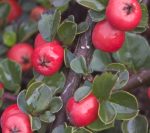 Native to the mountains of southwestern China, this deciduous to evergreen shrub grows 2-3’ tall with a spread of 3-6’. It is a member of the rose family, Roaseae, that also includes cherry, lady’s mantle and pyracantha. Its arching reddish branches grow in a herringbone pattern and carry ¾” long rounded dark green glossy leaves that have a pointed tip and turn red to purple in autumn. Clusters of small pink flowers attractive to bees appear in early summer and give way to small showy red fruits attractive to birds. Plants are tolerant of dryness, salt-spray, and alkaline soil, and is especially useful as a ground cover or for erosion control on a slope but are considered invasive in the Great Lakes states, California, and Pacific Northwest. The generic name cotoneaster comes from the Latin word cotoneum meaning quince and the suffix -aster meaning resembling. The specific epithet, apiculatus, means having a pointed tip and prefers to the leaves.
Native to the mountains of southwestern China, this deciduous to evergreen shrub grows 2-3’ tall with a spread of 3-6’. It is a member of the rose family, Roaseae, that also includes cherry, lady’s mantle and pyracantha. Its arching reddish branches grow in a herringbone pattern and carry ¾” long rounded dark green glossy leaves that have a pointed tip and turn red to purple in autumn. Clusters of small pink flowers attractive to bees appear in early summer and give way to small showy red fruits attractive to birds. Plants are tolerant of dryness, salt-spray, and alkaline soil, and is especially useful as a ground cover or for erosion control on a slope but are considered invasive in the Great Lakes states, California, and Pacific Northwest. The generic name cotoneaster comes from the Latin word cotoneum meaning quince and the suffix -aster meaning resembling. The specific epithet, apiculatus, means having a pointed tip and prefers to the leaves.
Type: Deciduous to evergreen shrub
Outstanding Feature: Berries
Form: Arching, sprawling
Growth Rate: Slow
Bloom: Clusters of small pink flowers in early summer
Size: 2-3’ H x 3-6’ W
Light: Full sun
Soil: Average, medium moist, well-drained but tolerates some drought
Hardiness: Zones 4-7
Care: Low maintenance
Pests and Diseases: Generally healthy but susceptible to spider mites in dry conditions and fireblight.
Outstanding Selection:
‘Tom Thumb” (more compact)
‘Blackburn’